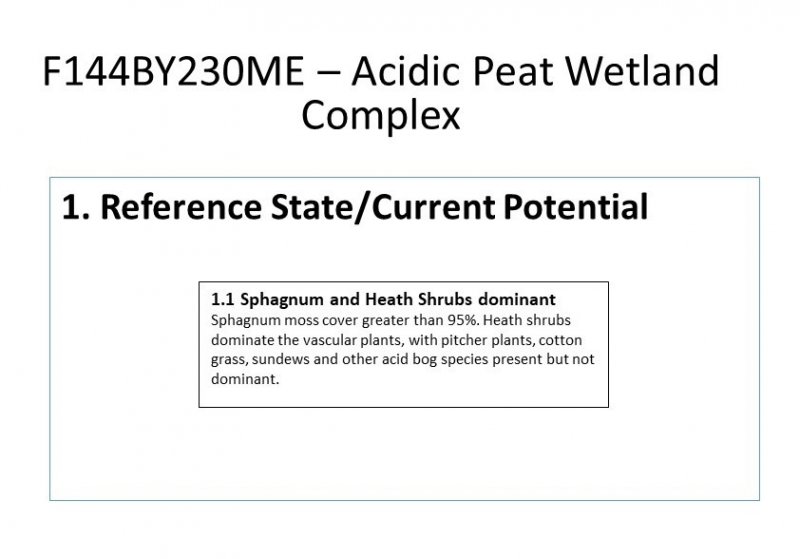
Natural Resources
Conservation Service
Ecological site F144BY230ME
Acidic Peat Wetland Complex
Last updated: 5/13/2025
Accessed: 12/21/2025
General information
Provisional. A provisional ecological site description has undergone quality control and quality assurance review. It contains a working state and transition model and enough information to identify the ecological site.
MLRA notes
Major Land Resource Area (MLRA): 144B–New England and Eastern New York Upland, Northern Part
This major land resource area (MLRA) is in Maine (56 percent), New Hampshire (22 percent), Vermont (14 percent), Massachusetts (6 percent), Connecticut (1 percent), and New York (1 percent). It makes up about 22,728 square miles (58,864 square kilometers). The MLRA consists of a relatively young landscape shaped by the Laurentide Ice Sheet, which covered the region from 35,000 to 10,000 years ago. Rolling hills of dense basal till converge on ridges of shallow bedrock that were scoured by glacial ice. River valleys that were flooded by melting glacial water or seawater house large expanses of glacial outwash and stratified drift in inland areas and, to a lesser extent, glaciomarine and glaciolacustrine sediment deposits in coastal areas. Organic bogs, ablation till, and alluvial flood plains make up the remaining portions of the MLRA.
The soils in this region are dominantly Entisols, Spodosols, and Inceptisols. They commonly have a fragipan. The dominant suborders are Ochrepts, Orthods, Aquepts, Fluvents, and Saprists. The soils in the region dominantly have a frigid soil temperature regime with some cryic areas at higher elevation, a udic soil moisture regime, and mixed mineralogy. Most of the land is forested, and 98 percent is privately owned. Significant amounts of forest products are produced including lumber, pulpwood, Christmas trees, and maple syrup. Principal agricultural crops include forage and grains for dairy cattle, potatoes, apples, and blueberries. Wildlife habitat and recreation are important land uses. Stoniness, steep slopes, and poor drainage limit the use of many of the soils.
Classification relationships
NRCS:
Land Resource Region: R—Northeastern Forage and Forest Region
MLRA: 144B—New England and Eastern New York Upland, Northern PartMLRA resources
Major Land Resource Area (MLRA): 144B–New England and Eastern New York Upland, Northern Part
Ecological site concept
This site occurs in flat, low-lying areas characterized by very poorly-drained acidic peat soils and acid bog vegetation. Soil pH is generally below 4.5 throughout (usually below 4.0)
The vegetation of this site is dominated by sphagnum moss and heath shrubs, along with other common bog species such as pitcher plant, cotton grass, sundews, etc. in lower quantities. This site may sometimes support stunted black spruce and larch trees, not more than a few feet tall.
This site is resistant to major disturbances except for small scale hydrologic alterations that may create small patches of drained or ponded peatland (such as near a culvert). This ecological resistance can be attributed to the ability of these bogs to respond to large fluctuations in water, as the peat acts like a sponge, expanding and contracting with the water supply. There is also a general resistance to fire, insects, disease, construction, land management, etc. due to the wet nature and particular species on the site. Further study is needed to identify alternative states for this site.
Associated sites
| F144BY220ME |
Semi-acidic Peat Wetland Complex The Semi-acidic Peat Wetland Complex often surrounds the Acidic Peat Wetland Complex as it grades into higher areas in the watershed |
|---|
Similar sites
| F144BY220ME |
Semi-acidic Peat Wetland Complex The Acidic Peat Wetland Complex has pH less than 4.5 throughout the profile, compared to pH greater than 4.5 in at least part of the profile for Semi-acidic Peat Wetlands. The lower pH results in the most acidic bog indicator plants, such as pitcher plants and sundews. |
|---|---|
| F144BY210ME |
Marsh Wetland Complex The Marsh Wetland Complex occurs in a similar landscape position, but has more nutrient and oxygen-rich soil water conditions, resulting in the decomposition of organic matter into muck, rather than the peat accumulation characteristic of the Acidic Peat Wetland Complex. |

Figure 1.
Table 1. Dominant plant species
| Tree |
(1) Populus balsamifera |
|---|---|
| Shrub |
Not specified |
| Herbaceous |
Not specified |
Click on box and path labels to scroll to the respective text.
